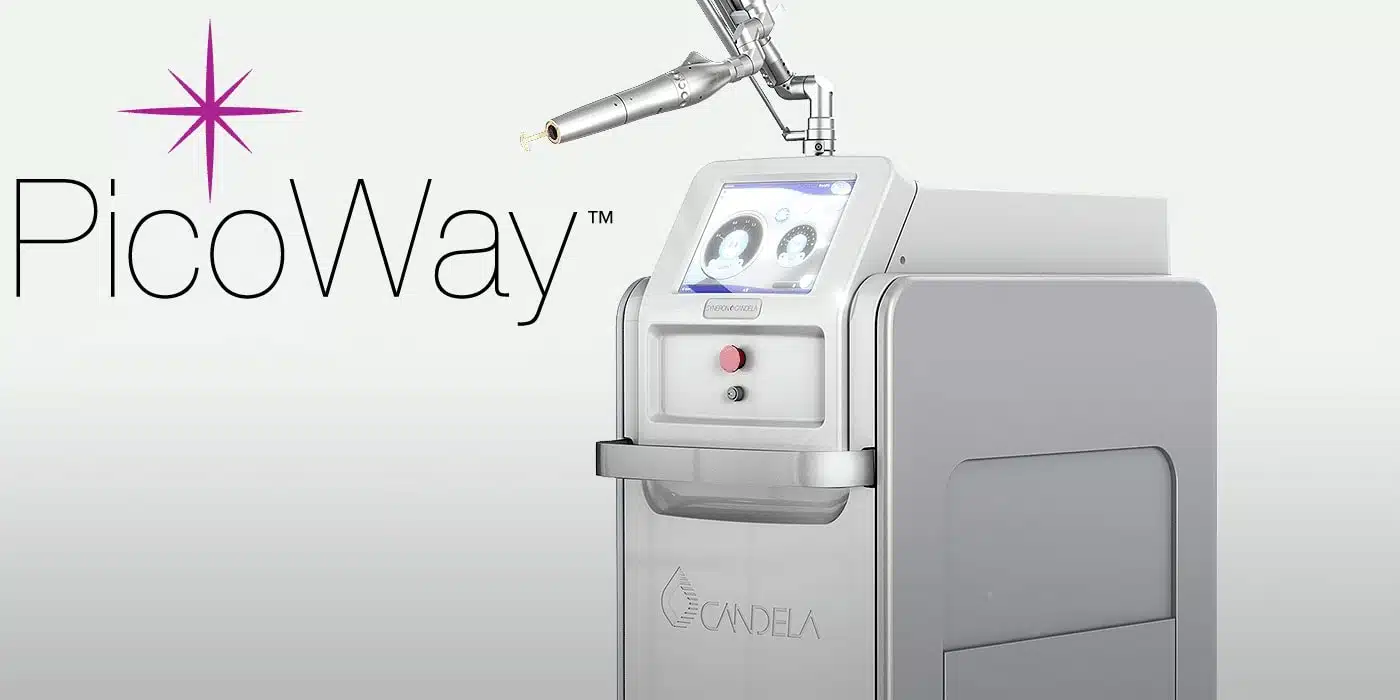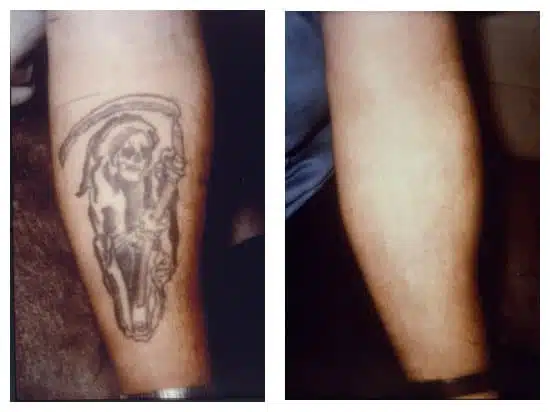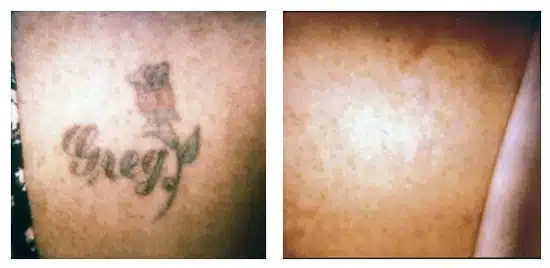To all our valued clients, you can now save time and money by booking appointments with our app. Download And Sign Up For Our Rewards Program Click HERE
Laser Tattoo Removal In Glendale, CA
Laser Tattoo Removal
Laser Tattoo Removal is a non-invasive treatment aimed at eliminating unwanted tattoos from the skin. This procedure operates by using concentrated laser beams to dissolve the ink particles within the tattoo. These fragmented particles are then naturally processed and removed by the body’s immune system. Laser Tattoo Removal is effective on a range of tattoo colors and designs, making it suitable for nearly any part of the body, including arms, legs, chest, back, and even delicate areas like the face. With advanced laser technology, this treatment can address tattoos of all sizes and ink depths, providing a reliable option for those looking to remove or significantly lighten their tattoos.
This treatment is beneficial for individuals who are unhappy with their tattoos due to a change in personal taste, lifestyle, or professional requirements. It is also ideal for those who have experienced poor tattoo artistry and wish to remove or correct the ink. Many patients begin to notice fading after just a few sessions, with optimal results typically achieved after multiple treatments, depending on the tattoo’s size, color, and age. Results are long-lasting, and once the tattoo is completely removed, it does not return. For those considering Laser Tattoo Removal in Glendale, CA, booking an appointment is recommended to discuss your specific needs and start the tattoo removal process at New Look Skin Center.

The Candela PicoWay produces an intense, but gentle burst of light that allows selective destruction of the over-abundance of melanin seen in benign pigmented lesions or fragments and removes tattoo pigments without damaging surrounding tissue. The purpose of this procedure is to attempt removal of the tattoo or to make the pattern as unrecognizable as possible by lightening the pigment pattern.
Before & After


Patient Testimonials
"New Look Skin Center is an amazing experience altogether. The staff is always very friendly and I always make my appointments first thing in the morning and they are always on time, they take care of what they need to and I'm on my way. The cleanliness of the staff is always well-measured and I would definitely recommend this place to anyone."
Vincent M.
"I have been using this company for years now and I love them. It's always super clean and the service is awesome. I was recently serviced by Irene with front desk and Courtney was my nurse, they were both so sweet and made my visit a great experience!"
Linda M.
Click here to read more reviews.
Benefits of Laser Tattoo Removal:
- Effectively removes a wide range of tattoo colors.
- Non-invasive treatment with minimal discomfort.
- Precision targeting of tattoo ink without damaging surrounding skin.
- Safe for all skin types and body areas.
- Lower risk of scarring compared with other removal methods.
- Gradual fading with each session for controlled results.
- Quick treatment sessions with little to no downtime.
- Long-lasting results after the tattoo is removed.
- Can lighten tattoos for cover-up designs.
- Reliable option for correcting tattoo regret or poor artistry.
FAQ
How many treatments are needed and how often?
The number of treatments recommended for Laser Tattoo Removal depends on factors such as the tattoo’s size, color, and depth. On average, patients need 6 to 10 sessions to achieve the best results. Treatments are typically spaced 6 to 8 weeks apart to provide time for the skin to heal and for the body to process the fragmented ink particles.
What color tattoos respond best?
Darker colors, such as black and dark blue, respond best to Laser Tattoo Removal because they absorb the laser energy more efficiently. Lighter colors like green, yellow, and white are more challenging to remove, but advancements in laser technology have made it possible to treat these colors with varying success.
Do all tattoos respond?
Most tattoos respond well to laser treatments, though some may be more resistant due to factors like ink type, age of the tattoo, and its location on the body. Older tattoos, which have naturally faded over time, are more straightforward to remove than newer ones. However, tattoos with certain pigments or those located in areas with less blood flow may require additional sessions.
What should I expect immediately after treatment?
After a Laser Tattoo Removal session, the treated area may swell, redden, and feel like a mild sunburn. These side effects are temporary and usually subside within a few days. You may also notice the tattoo appearing white or frosted immediately after treatment, which is a normal reaction to the laser.
What is the recommended care after the procedure?
Proper aftercare is essential for optimal outcomes and preventing complications. Patients must maintain the treated area clean and dry, avoid direct sunlight, and apply any prescribed ointment to aid healing. It is also important to avoid picking at any scabs that may form, as this could lead to scarring.
What's the contraindications with laser tattoo removal?
Laser Tattoo Removal is not suitable for everyone. Individuals with certain medical conditions, including active skin infections, a history of keloid scarring, or those who are pregnant, should avoid this treatment. It is important to consult with a qualified provider to determine if this procedure is appropriate for you based on your medical history and skin type.
How many treatments are needed and how often?
Removal of a tattoo is based on several things:
- The depth of penetration of the ink; color; density; application; the patient’s immune system and ability to heal; skin type and the location of the tattoo.
Most simple tattoos are removed in 2-4 treatments scheduled about 4-8 weeks apart. Removing complex tattoos often requires a series of treatments spaced approximately 8 or more weeks apart. Professional tattoos usually require 6-10 or more treatments for complete clearing.
What color tattoos respond best?
Black and blue respond the best while red, purple or orange present more of a challenge also. Yellow is perhaps the most difficult since it actually tends to reflect the laser light rather than absorb it. A large number of sessions are required to see fading.
Do all tattoos respond?
Amateur or poorly done tattoos may not respond to treatment. This is because it was probably placed at the wrong level in the skin where it may not be responsive to the laser light.
What should I expect immediately after treatment?
Immediately after your session, the treated area will have a whitish/grey or red discoloration with pinpoint bleeding and some oozing and blistering. Swelling lasting several days is not unusual. The area treated will remain; icing and application of an antibiotic ointment. The practitioner will apply antibiotic ointment and dry dressing immediately following the treatment. Visible improvement or any change will be seen when healing is complete, generally, a few weeks preceding treatment. At times, 6-10 or more treatments for complete clearing.
What is the recommended care after the procedure?
• Ice, wrapped in a soft cloth, may be applied to the treated area to reduce discomfort, swelling, or any inflammation.
• No rubbing, scratching or picking to treated area.
• Avoid sports which may cause excessive sweating as well as tight clothing that may cause pressure.
• No sun exposure during entire duration of treatments. SPF 30 or higher is recommended if sun exposure cannot be avoided.
• Clean the treated area daily with mild soap and water and gently pat dry. Apply a thin layer of antibiotic ointment, such as polysporin or bacitracin, twice a day and cover with dressing. Generally, 7 to 14 days.
• Tylenol may be used for discomfort if necessary, but avoid aspirin
What's the contraindications with laser tattoo removal?
• Pregnancy
• An infected tattoo site
• Tanning – avoid sun 4 weeks before the treatment
• Avoid using photosensitivity medications 1 week before treatment, except for Accutane, which requires a wait time of 6 months minimum.
• Treatment is not recommended for the patients who suffer from any medical problems such as skin disorders, heart problems, cancer, seizures, and any immune system disorders or have implanted medical devices. IN THESE CASES, CLEARANCE FROM OWN’S PRIMARY PHYSICIAN IS REQUIRED TO PERFORM ABY LASER REMOVAL PROCEDURE.
• Herpes simplex virus 1,2 patients must begin prophylactic medication 1 week before treatment.
• Keloid scarring.
What are the possible side effects?
Side effects of laser tattoo removal are rare but may include blistering, infection, loss of skin color, or scabbing. If scabbing occurs, it usually subsides within two weeks. In most cases, skin returns back to normal.
Are there any guarantees for the laser tattoo removal?
There is no guarantee, warranty or assurance regarding the outcome or any improvements of your condition due to this procedure. Complete tattoo removal is not always possible as tattoos were meant to be permanent.
Easily Schedule Your Appointment Online Today
If you have any questions or concerns, please utilize our contact form here.
Get in Touch with Us
We will respond to your inquiry as soon as possible. If you are looking to book an appointment, please do so online here.
We encourage your feedback, please feel free to send us a message using the following contact form.